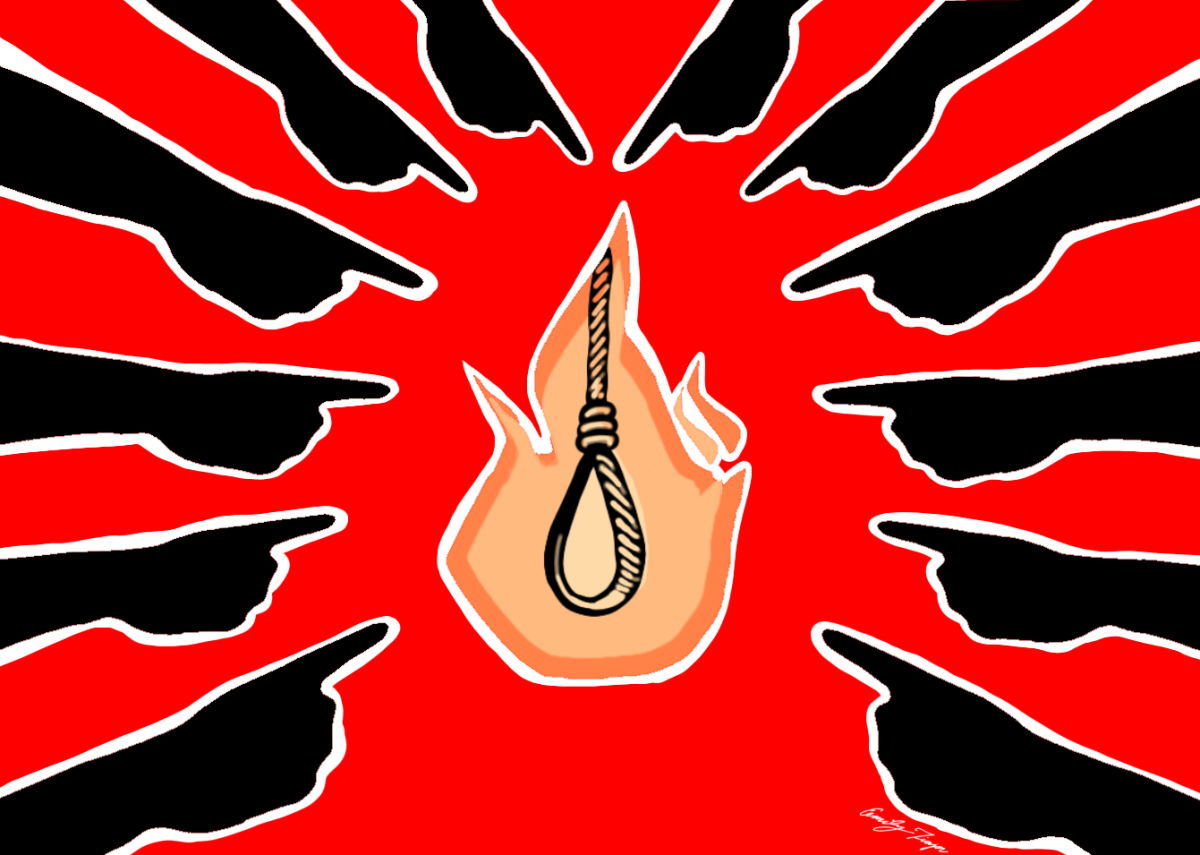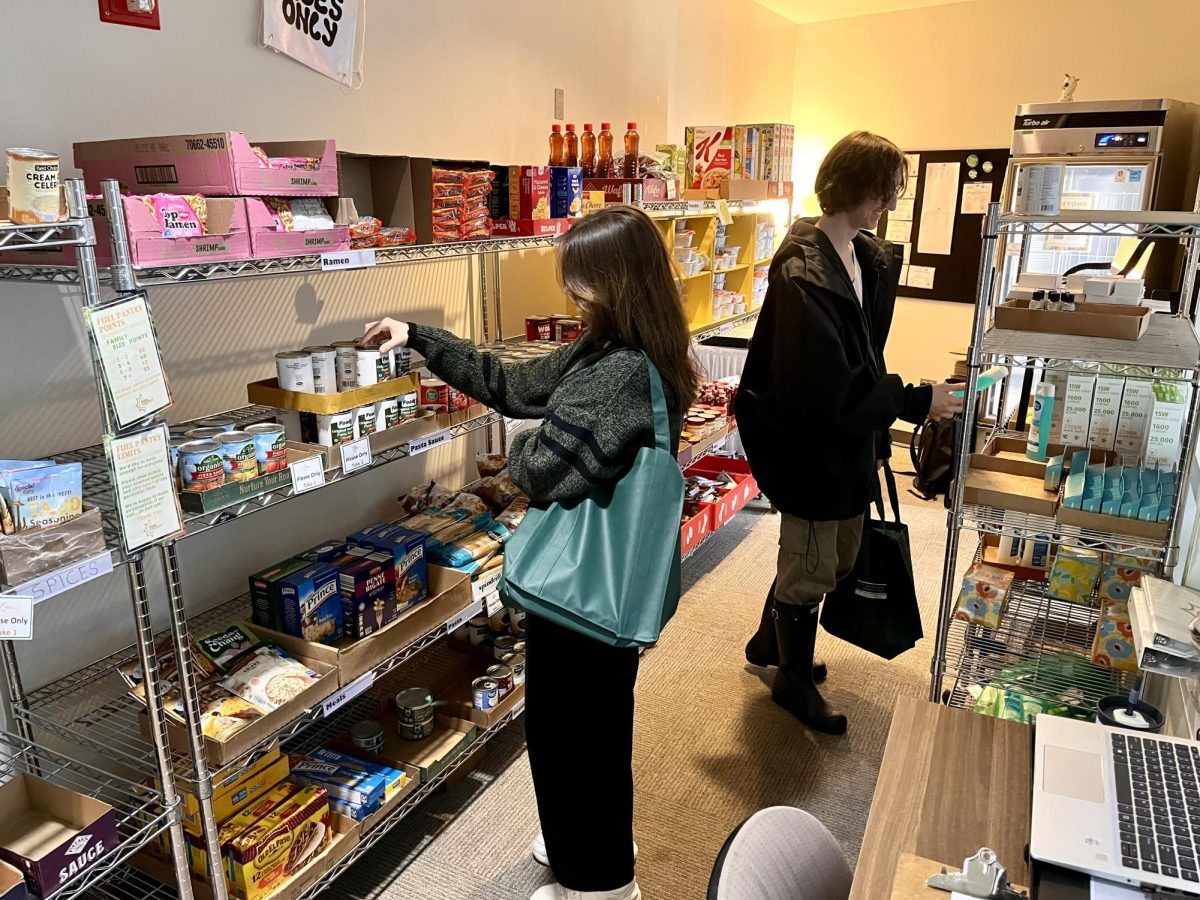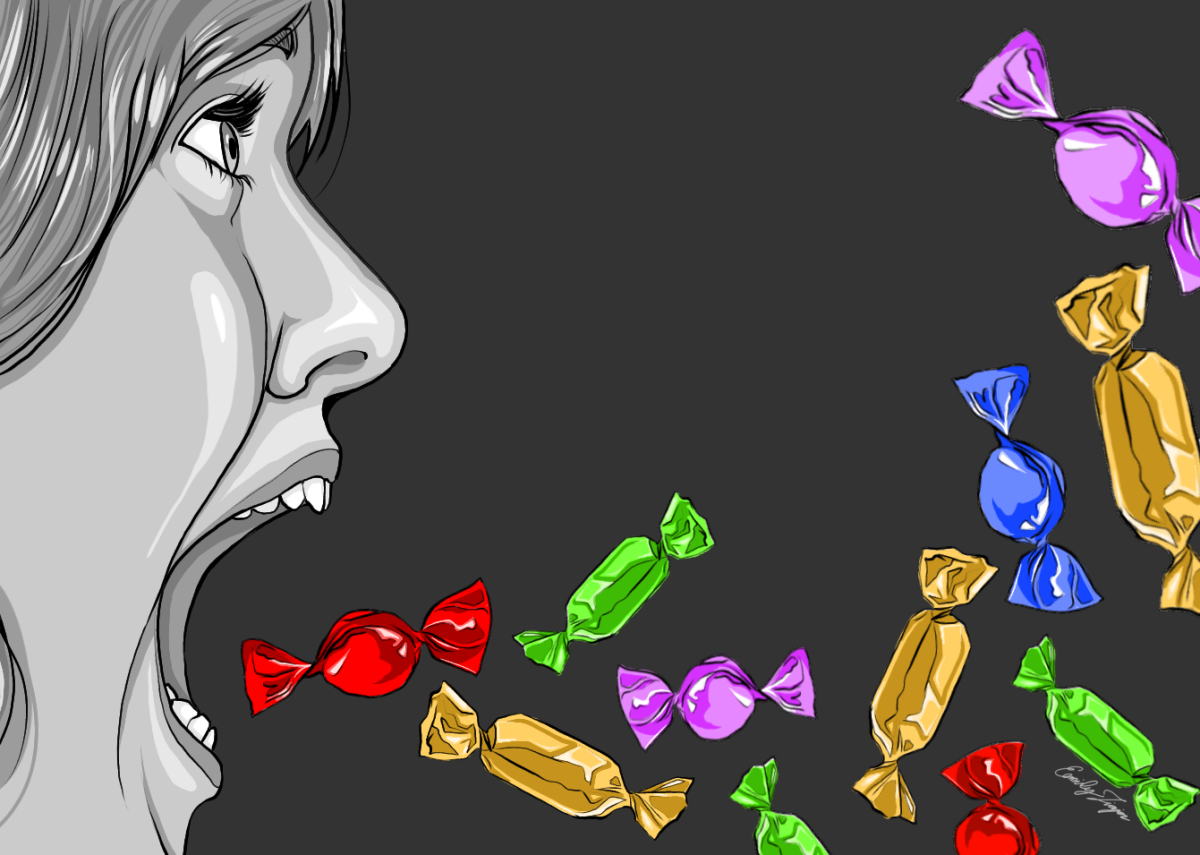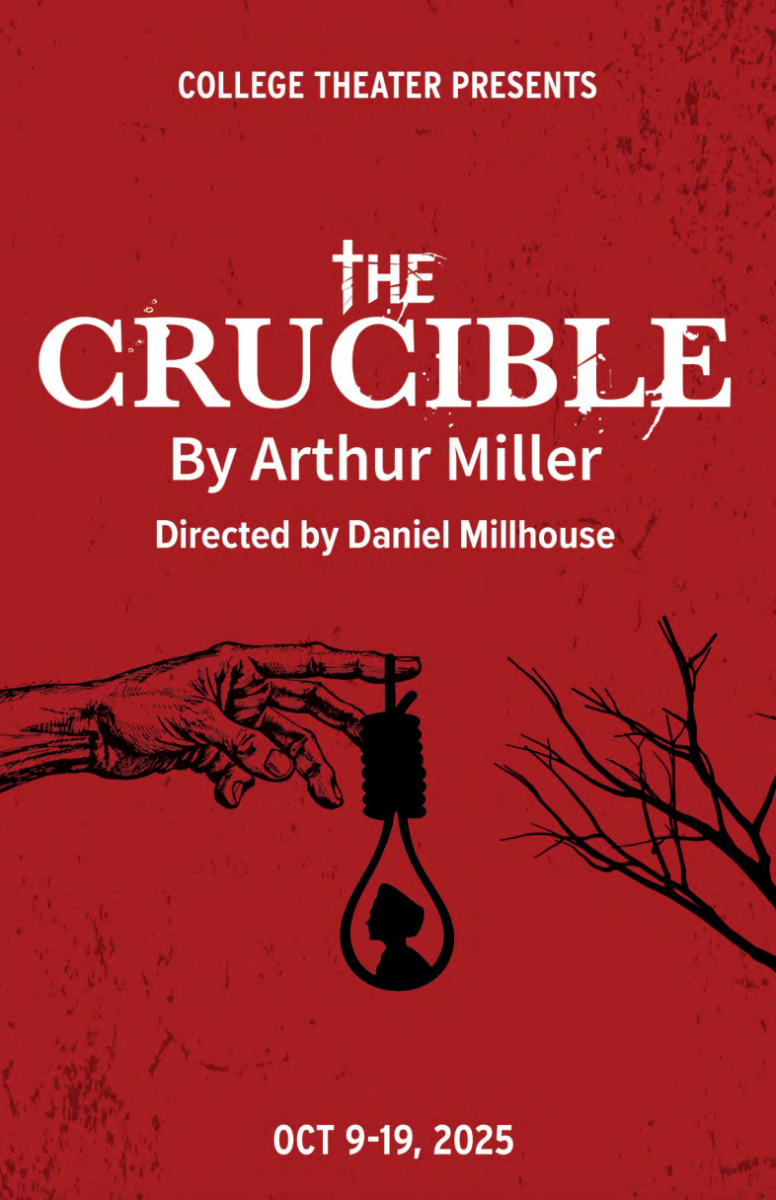“This Is A Censored Exhibition”: Art Gallery About Ohio Train Derailment
Art students used video, audio, and sculpture art to explore the lack of media coverage about the Feb. 3 Ohio train derailment in the “This Is A Censored Exhibition” gallery.
Artists of the Exhibit: Grace Cliff, Tess McBride, Alex Morgan, Angelo Mendez, Evan Benson (left to right)
March 6, 2023
News footage of a fiery train wreck and paragraphs about chemical pollution covered the walls of the Wings Gallery at College of DuPage this week. A group of five artists collaborated on this exhibition for their Time Based Media classes. They were motivated by the news of a large freight train carrying hazardous chemicals that derailed in the rural village of East Palestine, Ohio on Feb. 3. The students decided it was crucial to give attention to the incident in the context of censorship.

One of the artists was Fine Arts student Angelo Mendez. He described how the exhibit’s stylistic title “This Is A Censored Exhibition” references the lack of media coverage about the train derailment and the chemical pollutants affecting the land.
“This incident was tragic and is badly affecting the area,” Mendez explained. “The more we investigated it, the more we saw it was censored. This wasn’t meant to be brought to the public’s attention. But now it’s getting more mainstream. People are more aware of it, which we’re proud of. This incident was tragic, but it was also hidden.”
Another exhibition creator and art student, Tess McBride, mentioned how most large news outlets didn’t cover the event until the week of the Super Bowl on Feb. 12.
“It wasn’t a headliner, but it should have been,” McBride added. “It happened on Feb. 3, but it didn’t get released to the public until Super Bowl Day, which was probably on purpose. This isn’t the first time this kind of event has happened; this is just the first time we all decided to work on a project about this.”
This led the five students to design a captivating art piece that would publicize the incident.
Soon after the derailment, the Environmental Protection Agency (EPA) arrived at the site and released a letter listing the hazardous chemicals the train leaked into the surrounding area. The train company also conducted a controlled burn of some chemicals to prevent those from mixing and creating more toxic damage. The burn-off caused a large, thick plume of gray smoke to rise on Feb. 6, visible for miles all around.
McBride, who is an art education major, explained how the chemicals not only harm the environment but also affect the people living there.
“East Palestine has a lot of farmland that people rely on. Now that a lot of it is contaminated, it’s leaving people without food and safe water to drink, which is the bare minimum,” McBride said. “The life-long effects are that people in the area will get sick, primarily diagnosed with cancer.”
By Feb. 10, the EPA had detected various chemicals in local streams, such as vinyl chloride that can cause liver cancer after chronic exposure. These streams flow into the Ohio River, a major water source for areas around the Ohio border.
The students centered on the water sources as the main things polluted by the train derailment. The exhibition title screen is on a rainbow-hued pattern of swirling water. Mendez described the exploration of color in the exhibition.
“As I edited the video, I thought of how when water reacts with chemicals, it gets this oily rainbow effect,” Mendez described. “I wanted to emphasize that.”
Evan Benson, a sophomore majoring in art history, described his curatorial process in assembling the water jar displays. The water jars act as an important visual connector to the contamination at the site of the derailment. He collected water and aquatic plants from the DeShane Pond behind the MAC building to show clean water from our local water systems that we may take for granted.
“As a student in Time Based Media, I’m personally interested in how a static sculpture can be time-based too,” Benson explained. “It can have movement and duration. Since there are plants, moss and pine cones in these jars, over time they start to ferment and mold and turn different colors. They get residue and soil deposit on the bottom. They’re visually engaging, and we have the high-saturated projections of oil shine through the water jars, which is almost reminiscent of pollution.”

Benson’s display represents the way wildlife organically changes until chemicals are introduced. The pond water in the jars is naturally yellowish with plants in it, compared to chemically contaminated water.
Residents of East Palestine have been testing their water wells and complained of chemical stenches that have caused headaches, coughing, and swollen eyes. On Feb. 22, the Ohio Emergency Management Agency reported that the municipal water systems were free from contaminants released by the train derailment. Residents were allowed to return to their homes, but they are still encouraged to only drink bottled water. As this unfolds, media outlets have released aerial videos of smoke plumes from the chemicals burning at the train wreck and the Ohio River turning pink.
The art students made use of this kind of news footage in their exhibit’s video loop. One of the video creators was Grace Cliff, who has a degree in graphic design and creative technology. She experimented with different scales and sizes for each video, which were patched together in an overlapping collage style.
“I wanted it to be very overwhelming. To have the viewer be involved in the work by being able to interact and censor the content with their own body, physically covering up the projections,” Cliff described. “I also had animations of the train collision and the Leslie river that was contaminated in the collision. I also put an emphasis on the text, primarily using black, white and red for the colors.”
The exhibit uses multiple projectors to fill the walls with videos and words. The largest wall has continuous news footage reels. Beside it, pages of text describe the incident, list the chemicals, and include quotes from concerned East Palestine residents and the EPA. Black rectangles cover some phrases to reference the theme of censorship. As a person enters the room and stands in the center, their body will block some of the projection lights and cast a shadow onto the wall of videos.
The students described their exhibition as a union between technical projects and fine arts. The musical aspect was created by exhibit artist and Time Based Media student Alex Morgan. He created an audio loop that has train alarms, yelling voices and a symphony tuning its strings. It drowns out all other sounds and fills the exhibit with a suspenseful feeling of anxiety.
“I wanted to incorporate the elements of fire and water, the groundwater being polluted,” Morgan described. “The orchestra is a tuning session with violins, representing that we’re getting ready and going up to this big moment. Then, it drops off. For the screaming voices, I took a clip from ‘Modern Housewives.’ There was a lot of bleeping, so I wanted to use that. Over time their voices get mingled, it turns into one tone, then the censor noise rings on.”
These discordant sounds are brought together with the melodic background music, which Morgan deliberately sampled from a song about censorship, “One Very Important Thought” by Boards of Canada.
He hopes the work he and the team of artists put into the exhibition will inspire people to come together and care for each other in times of tragedy.
“We need to bring people together, build community; that is the only thing standing in the way of destruction when things like this happen,” Morgan said. “These companies are not gonna help you. The government is not gonna help you. The people around you are the most important.”
The exhibition also is a tribute to the environmental destruction that occurred in this incident and others like it. McBride described the impact she hopes the exhibit will have on people.
“What I hope people can take away from this exhibit is to read more, educate yourself,” McBride added. “People could think of this as a political piece; it’s not. If you’re thinking that way, maybe just read up about the environmental implications. Educating others is a good step in awareness about environmental conditions.”
Using their academic project to carry a wider message is one way these art students have raised awareness about the fallout of the train derailment. On a wider scale, people have been extending aid to the residents of East Palestine through organizations like The Brightside Project and The Way Station. There have also been bipartisan proposals from Ohio senators and members of Congress to increase safety precautions and regulations on freight trains carrying hazardous materials.





















Bridget GMS • Mar 7, 2023 at 10:09 am
Thank you for an enlightening exhibit about the Ohio River becoming contaminated by a train derailment. I used to live in Columbus, OH. I will send a copy of your article to my 19-year old son who still lives there with his dad.
Mariyam Syed • Mar 10, 2023 at 1:50 pm
Thank you for reading, Bridget! The students did a good job to raise awareness about the incident through their exhibit. I hope your son is faring well and the situation in Ohio becomes safe quickly.